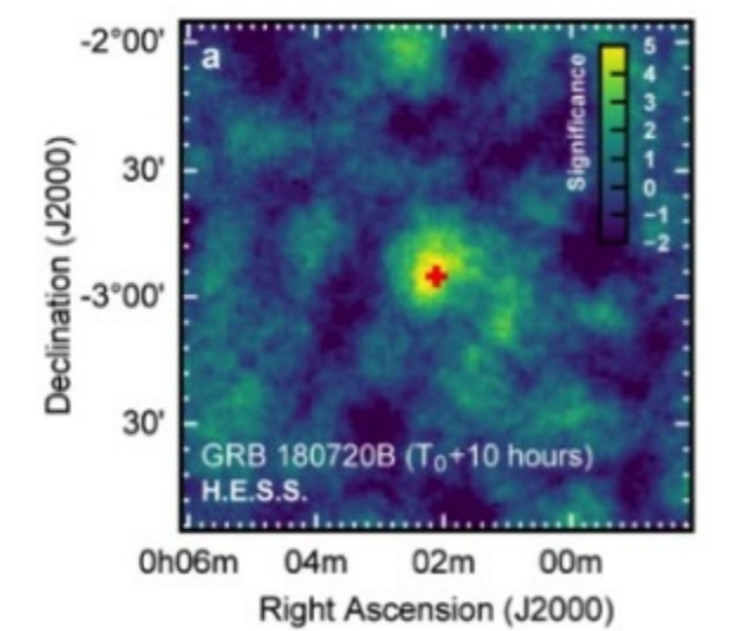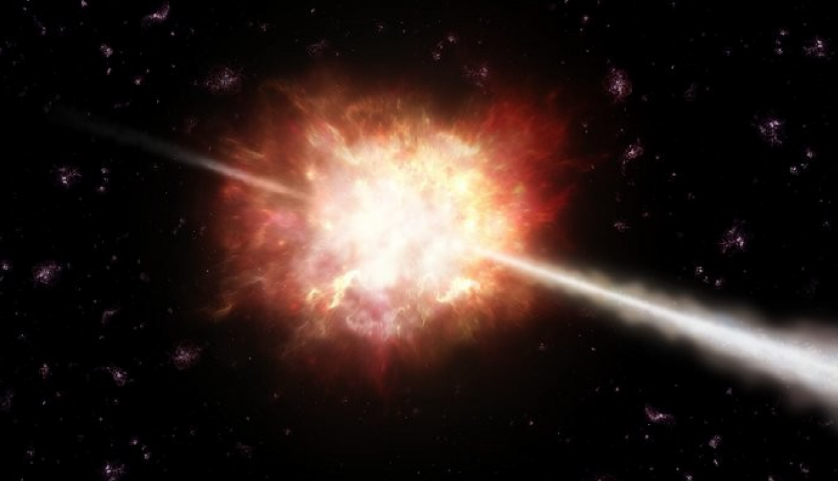Astronomy Object of the Month: 2019, December
< previous Archive next >
First detection of gamma-ray burst afterglow in very-high-energy gamma light
After a decade-long search, scientists have for the first time detected a gamma-ray burst in very-
high-energy gamma light. This discovery was made in July 2018 by the H.E.S.S. collaboration
using the huge 28-m telescope of the
H.E.S.S.
array in Namibia. Surprisingly, this Gamma-ray burst, an extremely energetic flash following a
cosmological cataclysm, was found to emit very-high-energy gamma-rays long after the initial explosion.
 Illustration:
GRB 180720B in very-high-energy gamma light, 10 to 12 hours after the burst as seen by the large
H.E.S.S. telescope. The red cross indicates the position of GRB 180720B, determined from the optical
emission of the GRB. Credit: H.E.S.S. collaboration, email: contact.hess@hess-experiment.eu.
Illustration:
GRB 180720B in very-high-energy gamma light, 10 to 12 hours after the burst as seen by the large
H.E.S.S. telescope. The red cross indicates the position of GRB 180720B, determined from the optical
emission of the GRB. Credit: H.E.S.S. collaboration, email: contact.hess@hess-experiment.eu.
Extremely energetic cosmic explosions generate gamma-ray bursts (GRB), typically lasting for only a few tens of seconds. They are the most luminous explosions in the universe. The burst is followed by a longer lasting afterglow mostly in the optical and X-ray spectral regions whose intensity decreases rapidly. The prompt high energy gamma-ray emission is mostly composed of photons several hundred thousands to millions of times more energetic than visible light, that can only be observed by satellite-based instruments. Whilst these space-borne observatories have detected a few photons with even higher energies, the question if very-high-energy (VHE) gamma radiation (at least 100 billion times more energetic than visible light and only detectable with ground-based telescopes) is emitted, has remained unanswered until now.
On 20 July 2018, the Fermi Gamma-Ray Burst Monitor and a few seconds later the Swift Burst Alert Telescope notified the world of a gamma-ray burst, GRB 180720B. Immediately after the alert, several observatories turned to look at this position in the sky.
For H.E.S.S. (High Energy Stereoscopic System), this location became visible only 10 hours later. Nevertheless, the H.E.S.S. team decided to search for a very-high-energy afterglow of the burst. After having looked for a very-high-energy signature of these events for more than a decade, the efforts by the collaboration now bore fruit.
A signature has now been detected with the large H.E.S.S. telescope that is especially suited for such observations. The data collected during two hours from 10 to 12 hours after the gamma-ray burst showed a new point-like gamma-ray source at the position of the burst. While the detection of GRBs at these very-high-energies had long been anticipated, the discovery many hours after the initial event, deep in the afterglow phase, came as a real surprise. The discovery of the first GRB to be detected at such very-high-photon energies is reported in a publication by the H.E.S.S. collaboration et al., in the journal 'Nature' on Nov. 20, 2019.
A team of researchers from 5 Polish scientific institutions took part in the discovery, including the University of Warsaw, Jagiellonian University, CAMK PAN, UMK and IFJ PAN. Poland participates in the works of the H.E.S.S. Observatory since 2005. It is worth noting that the large telescope used in the present discovery was also built with our participation. The announcement of the discovery in Nature was accompanied by a parallel presentation of a similar discovery made independently for another gamma-ray burst by the MAGIC observatory, with the participation of Polish researchers from the University of Lodz.
 Illustration:
Artist’s view of a GRB and the formation of extremely fast jets. Credit: ESO/A. Roquette.
Illustration:
Artist’s view of a GRB and the formation of extremely fast jets. Credit: ESO/A. Roquette.
Original publication: Abdalla, H., Adam, R., Aharonian, F. et al.: A very-high-energy component deep in the γ-ray burst afterglow, Nature, 575, 464–467 (2019).
Presented results are a part of research conducted at the Department of High Energy Astrophysics and Department of Stellar and Extragalactic Astronomy of the Jagiellonian University’s Astronomical Observatory. A group of researchers from the JU Astronomical Observatory: Marek Jamrozy, Michał Ostrowski, Łukasz Stawarz and PhD student Angel Priyana Noel participate in the works of the H.E.S.S. observatory.
|
Michał Ostrowski Astronomical Observatory Jagiellonian University M. Ostrowski [at] oa.uj.edu.pl |


